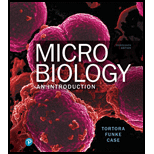
Microbiology: An Introduction (13th Edition)
13th Edition
ISBN: 9780134605180
Author: Gerard J. Tortora, Berdell R. Funke, Christine L. Case, Derek Weber, Warner Bair
Publisher: PEARSON
expand_more
expand_more
format_list_bulleted
Concept explainers
Textbook Question
Chapter 1, Problem 7R
NAME IT What type of microorganism has a peptidoglycan cell wall, has DNA that is not contained in a nucleus, and has flagella?

Expert Solution & Answer
Want to see the full answer?
Check out a sample textbook solution
Students have asked these similar questions
In the diagram below, identify the structures of a cyanobacterial cell based on the following descriptions:
a) Outer cellular covering which includes:
Mucilaginous layer – outermost layer covering the cell wall; protects the cell from harmful factors of the environment
Cell wall – found just below the mucilaginous layer; 2 or 3-layered, the inner layer lies in between the outer wall layer and plasma membrane; the outer layer is made of peptidoglycan
Innermost plasma membrane – selectively permeable membrane enclosing the cytoplasm
b) Cytoplasm – found below the plasma membrane; the protoplasm which contains structures of different shapes and functions. Lamellae, which contain pigments such as chlorophylls, carotenes, xanthophylls, phycoerythrin and phycocyanin, are located in the peripheral region of cytoplasm. Ribosomes may also be found scattered in the cytoplasm.
c) Nucleic material – the nucleoplasm that is centrally located in the cell and contains chromatin in the form…
Short, hairlike structures covering the surface of the cell used only by eukaryotic
cells for movement are called
O 1) pseudopodia.
O 2) fimbriae.
O 3) cilia.
O 4) pili.
O 5) flagella.
Identify the characteristics if it is prokaryotic or eukaryotic cells.
1. It contains organelles that are membrane bounded
2. No histones
3. It produce through binary fission
4. These are usually in the cytoplasm
5. They are usually microscopic and unicellular organism
6. They usually possess structures called pili
7. Cytoskeleton is absent
8. They are lack of nucleus
9. They secretes a layer of polysaccharide around the cell
10. Their genes are found in the nucleoid
Chapter 1 Solutions
Microbiology: An Introduction (13th Edition)
Ch. 1 - Review 1. How did the idea of spontaneous...Ch. 1 - Briefly state the role microorganisms play in each...Ch. 1 - Into which field of microbiology would the...Ch. 1 - Match the microorganisms in column A to their...Ch. 1 - Match the people in column A to their contribution...Ch. 1 - It is possible to purchase the following...Ch. 1 - NAME IT What type of microorganism has a...Ch. 1 - DRAW IT Show where airborne microbes ended up in...Ch. 1 - Prob. 1MCQCh. 1 - Which of the following is not a characteristic of...
Ch. 1 - Which of the following is the most important...Ch. 1 - Recombinant DNA is a. DNA in bacteria. b. the...Ch. 1 - Which of the following statements is the best...Ch. 1 - Which of the following is a beneficial activity of...Ch. 1 - It has been said that bacteria are essential for...Ch. 1 - Prob. 8MCQCh. 1 - Spallanzanis conclusion about spontaneous...Ch. 1 - Which of the following statements about E. coli is...Ch. 1 - How did the theory of biogenesis lead the way for...Ch. 1 - Even though the germ theory of disease was not...Ch. 1 - Prob. 3ACh. 1 - Find at least three supermarket products made by...Ch. 1 - People once believed all microbial diseases would...Ch. 1 - Prob. 1CAECh. 1 - In 1864, Lister observed that patients recovered...Ch. 1 - Prob. 3CAE
Knowledge Booster
Learn more about
Need a deep-dive on the concept behind this application? Look no further. Learn more about this topic, biology and related others by exploring similar questions and additional content below.Similar questions
- Which of the following statements is true? a) cells do not need ribosomes if they have mitochondriab) all cells have a cell membrane but not all cells have a cell wallc) all prokaryotes are unicellular and all eukaryotes are multicellulard) cells can have either a cell membrane or a cell wall or botharrow_forwardA major function of prokaryotic gas vesicles is to A) confer buoyancy on cells by decreasing their density. B) serve as a reservoir for oxygen and carbon dioxide. C) keep the cell's organelles separated during flagellar motion. D) store oxygen for aerobic growth when oxygen becomes depleted in the environment.arrow_forwardProkaryotes are classified by their shape and their cell arrangement. Identify the bacteria in the picture below. * Bacillus O Coccus Spirochete O Vibrio The absence of which organelle separates bacteria from being classified as eukaryotes?arrow_forward
- A bacteria cell which is longer than it is wide is classified as: Vibrio Coccus Bacillus Bacteria which normal colonize the human gut are classified as: Anaerobes Pathogens Aerobes A bacteria which absolutely needs oxygen to live is classified as: Obligate anaerobe Obligate aerobe Facultative anaerobe The structure on this list which will NOT be found in any bacterial cell is: Cytoplasm Flagella Nucleus The genetic information of bacteria cell is contained in the: Capsid Nucleoid Ribosomes The genetic material of a virion is called the: Genome Nucleoid Nucleusarrow_forwardWhich of the following statement/s is/are true about gram positive bacteria Cell wall has thick peptidoglycan layer Cell wall lipid content is very low Lipopolyscharride layer is absent All of the abovearrow_forwardWhich of the following is considered a distinguishing characteristic of prokaryotic cells?Question 6 options: a) They generally reproduce by binary fission. b) They possess a nucleus. c) They generally possess linear chromosomes. d) All of the above are true regarding most prokaryotes. e) None of the above are true.arrow_forward
- Mycoplasmas are bacteria that lack cell walls. On the basis of this structural feature, which statement concerning mycoplasmas should be true? They are gram-negative. They are subject to lysis in hypotonic conditions. They lack a cell membrane as well. They should contain less cellulose than do bacteria that possess cell walls. They possess typical prokaryotic flagella.arrow_forwardWhat protects cells from dehydration and nutrient loss, helps defend against phatocytosis, and helps with the formation of biofilms? Pili OFlagella Ribosomes Glyocalyx Nucleiod Mitochondia Fimbriaearrow_forwardWhat terms would describe a prokaryote that has is covered in a thick peptidoglycan layer, gets it's energy from eating other prokaryotes, and does not need oxygen to survive?arrow_forward
- 4) Which of the following statements is TRUE? A) Fimbriae are generally longer and less numerous than flagella. B) Fimbriae are involved in genetic exchange between cells. C) Hami are common in Bacteria but not found in Archaea. D) Fimbriae are usually shorter than flagella, whereas pili are involved in genetic exchange.arrow_forwardMatch the following structures with the group in which they can be found. Structure A cell wall made of cellulose A capsid A cell wall only made of a thick peptidoglycan layer An extracellular matrix Group Viruses Gram positive bacteria Animals Plantsarrow_forwardWhich of the following statement/s is/are true about gram negative bacteria Cell wall has thin peptidoglycan layer Cell wall lipid content is very low Lipopolyscharride layer is present All of the abovearrow_forward
arrow_back_ios
SEE MORE QUESTIONS
arrow_forward_ios
Recommended textbooks for you
 Human Anatomy & Physiology (11th Edition)BiologyISBN:9780134580999Author:Elaine N. Marieb, Katja N. HoehnPublisher:PEARSON
Human Anatomy & Physiology (11th Edition)BiologyISBN:9780134580999Author:Elaine N. Marieb, Katja N. HoehnPublisher:PEARSON Biology 2eBiologyISBN:9781947172517Author:Matthew Douglas, Jung Choi, Mary Ann ClarkPublisher:OpenStax
Biology 2eBiologyISBN:9781947172517Author:Matthew Douglas, Jung Choi, Mary Ann ClarkPublisher:OpenStax Anatomy & PhysiologyBiologyISBN:9781259398629Author:McKinley, Michael P., O'loughlin, Valerie Dean, Bidle, Theresa StouterPublisher:Mcgraw Hill Education,
Anatomy & PhysiologyBiologyISBN:9781259398629Author:McKinley, Michael P., O'loughlin, Valerie Dean, Bidle, Theresa StouterPublisher:Mcgraw Hill Education, Molecular Biology of the Cell (Sixth Edition)BiologyISBN:9780815344322Author:Bruce Alberts, Alexander D. Johnson, Julian Lewis, David Morgan, Martin Raff, Keith Roberts, Peter WalterPublisher:W. W. Norton & Company
Molecular Biology of the Cell (Sixth Edition)BiologyISBN:9780815344322Author:Bruce Alberts, Alexander D. Johnson, Julian Lewis, David Morgan, Martin Raff, Keith Roberts, Peter WalterPublisher:W. W. Norton & Company Laboratory Manual For Human Anatomy & PhysiologyBiologyISBN:9781260159363Author:Martin, Terry R., Prentice-craver, CynthiaPublisher:McGraw-Hill Publishing Co.
Laboratory Manual For Human Anatomy & PhysiologyBiologyISBN:9781260159363Author:Martin, Terry R., Prentice-craver, CynthiaPublisher:McGraw-Hill Publishing Co. Inquiry Into Life (16th Edition)BiologyISBN:9781260231700Author:Sylvia S. Mader, Michael WindelspechtPublisher:McGraw Hill Education
Inquiry Into Life (16th Edition)BiologyISBN:9781260231700Author:Sylvia S. Mader, Michael WindelspechtPublisher:McGraw Hill Education

Human Anatomy & Physiology (11th Edition)
Biology
ISBN:9780134580999
Author:Elaine N. Marieb, Katja N. Hoehn
Publisher:PEARSON

Biology 2e
Biology
ISBN:9781947172517
Author:Matthew Douglas, Jung Choi, Mary Ann Clark
Publisher:OpenStax

Anatomy & Physiology
Biology
ISBN:9781259398629
Author:McKinley, Michael P., O'loughlin, Valerie Dean, Bidle, Theresa Stouter
Publisher:Mcgraw Hill Education,

Molecular Biology of the Cell (Sixth Edition)
Biology
ISBN:9780815344322
Author:Bruce Alberts, Alexander D. Johnson, Julian Lewis, David Morgan, Martin Raff, Keith Roberts, Peter Walter
Publisher:W. W. Norton & Company

Laboratory Manual For Human Anatomy & Physiology
Biology
ISBN:9781260159363
Author:Martin, Terry R., Prentice-craver, Cynthia
Publisher:McGraw-Hill Publishing Co.

Inquiry Into Life (16th Edition)
Biology
ISBN:9781260231700
Author:Sylvia S. Mader, Michael Windelspecht
Publisher:McGraw Hill Education
Bacterial Structure and Functions; Author: Osmosis;https://www.youtube.com/watch?v=b15Hy3jCPDs;License: Standard youtube license